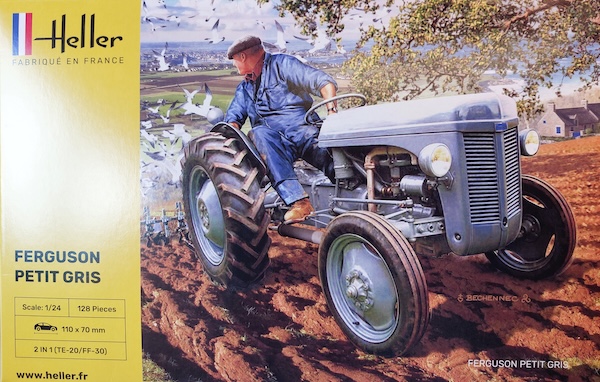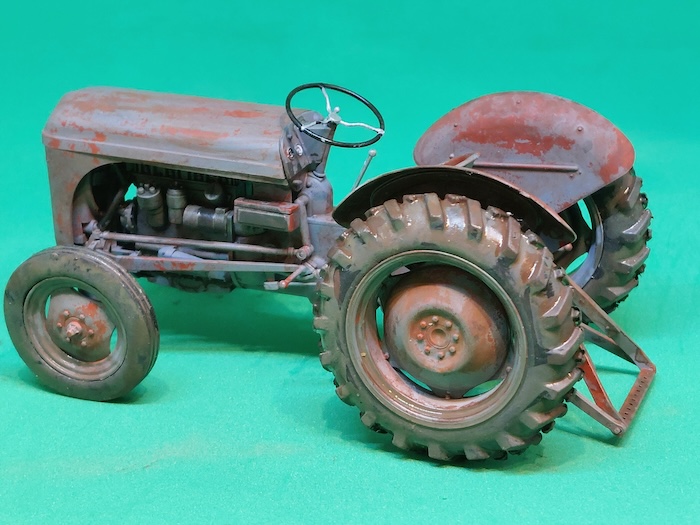
Full Review with Rob Ruscoe
Just before we get started, here’s a look at how it all turned out…

The TE-20 was the agricultural Tractor which revolutionised the way that the average farmer went about their business. Up until the end of the Second World War, existing machines were expensive and therefore out of reach of most of the farming community.
When Harry Ferguson introduced the ‘Little Grey Fergie’ in 1946, it was the first tractor to be affordable to the average farmer. Cheap but sturdy and reliable, the TE-20 also introduced the three-point hydraulic hitch system which is still standard on tractors today.
Ferguson reached an agreement in 1945, with the Standard Motor Company of Coventry, to produce his tractor. This was beneficial to both parties as the vehicle could be built in Standard’s huge wartime shadow factory which had produced aero engines during hostilities, and was now lying empty. Standard developed a new, wet-liner, four cylinder petrol engine for both the TE-20 and its new Vanguard motor car. Production at Coventry ran until 1956 by which time 517,651 tractors had been produced with two-thirds of these being exported worldwide.
Harry Ferguson merged his company with Massey-Harris of Toronto in mid-1953 – three years before TE-20 production ceased. The Ferguson 35 replaced the TE-20 on the line in late 1956.
As already stated, the early TE-20s ran on petrol. Later versions could have a tractor vapourising oil (TVO) engine fitted or, particularly popular in the UK, a three-cylinder Perkins diesel engine.
The Kit
When I was in my mid-teens, I decided that the money earned from a paper round was no longer enough. I heard that a local farmer required temporary workers to man his potato harvesting machine. This machine was configured with two lines of four people standing either side of a conveyor belt. The potatoes came onto this belt along with assorted stones and soil, where they were hand-picked and placed into two outer channels of the belt to be delivered to a moving trailer via an elevator arm. The stones and any rotten spuds were left to drop overboard. I only spent two days on this harvester before the dreaded flu bug struck two of the permanent farm workers. Being short of drivers and being the only member of the male gender among the potato machine crew, I was asked if I could drive. Being the proud owner of a Ford Prefect car, which I raced around a local field when I could afford 32p for a gallon of petrol, I soon found myself driving the little grey Fergie which towed the trailer alongside the moving potato machine. I was also put in charge of recruiting more women from the village as crew – most only lasted a few days in the freezing temperatures! I also continued to work on the farm during the school holidays for the next three years, driving Fordson Majors, Dextas and Super Dextas in a variety of tasks. My favourite tractors though, were the old TE-20 and the MF35.
It must have been over ten years later that I visited my old friends on the farm and, there in the barn, was the little grey Fergie still earning its keep even though it was, by then, more rust than grey.
It was whilst wandering around Scale Model World that I first saw the Heller kit of the TE-20 on sale. I had a little nostalgic chuckle to myself and then moved on. However, the thought of building that icon of my youth gained hold during the next few hours until I found myself back at the trader’s stand looking for the kit. Unfortunately it had been sold. A trawl of the internet soon had the postman knocking on the door with a box marked ‘Ferguson Petit Gris’ which, not speaking French, I assume was “Ferguson Little Grey”.
The box art depicts a very smartly overalled chap ploughing with a very pristine TE-20. Definitely not as I remember it! Not having built a Heller kit for a very long time, I opened the box with some trepidation and found, with some surprise, two sprues of nicely moulded grey styrene holding about 120 parts. Having re-checked it was Heller’s name on the box, the memory of badly fitting, ill-moulded kits of the past rapidly faded and I couldn’t wait to get started. The kit also included six rubber tyres – there is a choice of front tyres, and a small decal sheet containing the comprehensive instrument dials (two) and strangely, the headlamp lenses. I am glad the Fergie of my memory had no lights whatsoever as I’m not sure these decals would be convincing. The instructions are mostly okay but, some placements of parts are a bit vague in places so dry fitting is essential for these.